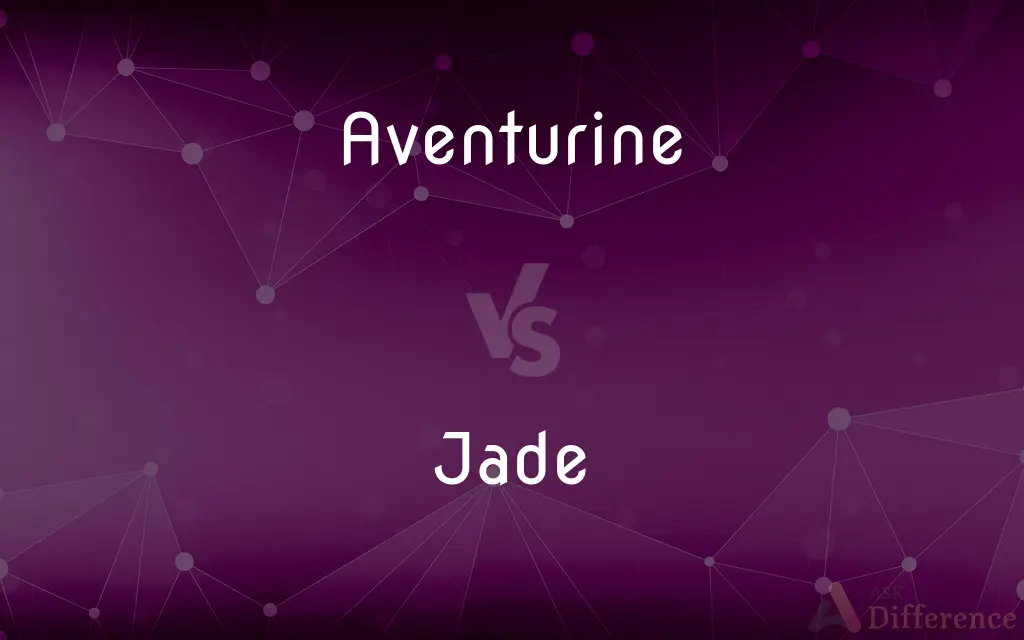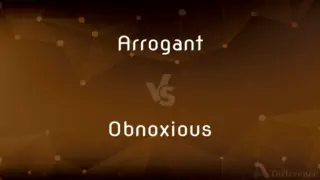Aventurine vs. Jade — What's the Difference?
Edited by Tayyaba Rehman — By Fiza Rafique — Updated on September 26, 2023
Aventurine is a shimmering quartz stone, often green, with mineral inclusions. Jade refers to two minerals, jadeite and nephrite, and is typically more uniform and intense in green color.

Difference Between Aventurine and Jade
Table of Contents
ADVERTISEMENT
Key Differences
Aventurine and Jade are both valued gemstones, frequently utilized in jewelry, carvings, and spiritual practices. Aventurine is a variety of quartz and is recognized for its sparkling appearance. This shimmer, often referred to as aventurescence, is due to tiny inclusions of mica or other minerals within the quartz. Though green Aventurine is the most common, the gem can be found in other colors, such as blue, peach, or brown.
Jade, on the other hand, is a name that encompasses two distinct minerals: jadeite and nephrite. Both of these minerals are used to produce what's commonly sold and appreciated as Jade. While jadeite offers a wider range of colors, from green to lavender, nephrite is typically found in cream or green shades. Jade has a deep historical significance, particularly in East Asia, and is considered a symbol of purity, nobility, and spirituality.
It's essential to understand that while both Aventurine and Jade can be green, their aesthetics and mineral compositions are different. Aventurine's appeal lies in its unique shimmer, while Jade's allure often comes from its intense and uniform coloration, smoothness, and historical context.
Moreover, in the world of crystal healing, both Aventurine and Jade have their distinct supposed benefits. Aventurine is often associated with prosperity and good luck, while Jade is believed to promote harmony, balance, and protection. While these beliefs vary among cultures and practitioners, both stones remain popular in metaphysical circles.
Comparison Chart
Composition
Quartz with mineral inclusions.
Refers to two minerals: jadeite and nephrite.
ADVERTISEMENT
Appearance
Shimmering due to aventurescence.
Smooth, often more uniformly colored.
Colors
Commonly green, but also blue, peach, brown.
Ranges from green to lavender, white, and more.
Historical Significance
Not as historically significant as Jade.
Deeply valued, especially in East Asian cultures.
Metaphysical Beliefs
Linked with prosperity and luck.
Associated with harmony, balance, and protection.
Compare with Definitions
Aventurine
A gemstone known for its sparkling appearance.
She loved the subtle shimmer of her Aventurine pendant.
Jade
A mineral gemstone, either jadeite or nephrite.
The artisan carved intricate patterns into the Jade stone.
Aventurine
A type of quartz containing mineral inclusions.
The necklace was made of shimmering Aventurine beads.
Jade
Holds significant cultural and historical value in many societies.
Jade artifacts are often found in ancient Chinese tombs.
Aventurine
Often green but can come in various colors.
The blue Aventurine caught her eye at the gem show.
Jade
Associated with purity, protection, and balance.
Many wear Jade pendants as symbols of protection.
Aventurine
Aventurine is a form of quartz, characterised by its translucency and the presence of platy mineral inclusions that give it a shimmering or glistening effect termed aventurescence.
Jade
Offers various colors, with green being the most iconic.
The lavender Jade earrings were a unique find.
Aventurine
An opaque or semitranslucent brown glass flecked with small metallic particles, often of copper or chromic oxide.
Jade
Jade is an ornamental mineral, mostly known for its green varieties, though it appears naturally in other colors as well, notably yellow and white. Jade can refer to either of two different silicate minerals: nephrite (a silicate of calcium and magnesium in the amphibole group of minerals), or jadeite (a silicate of sodium and aluminium in the pyroxene group of minerals).
Aventurine
Any of several varieties of quartz or feldspar flecked with particles of mica, hematite, or other materials. Also called sunstone.
Jade
A hard, typically green stone used for ornaments and implements and consisting of the minerals jadeite or nephrite
A jade figurine
Aventurine
A kind of brownish glass containing gold-coloured spangles.
Jade
A bad-tempered or disreputable woman.
Aventurine
A variety of translucent quartz, spangled throughout with scales of yellow mica.
Jade
An old or worn-out horse.
Aventurine
A kind of glass, containing gold-colored spangles. It was produced in the first place by the accidental (par aventure) dropping of some brass filings into a pot of melted glass.
Jade
Either of two distinct minerals, nephrite and jadeite, that are generally pale green or white and are used mainly as gemstones or in carving.
Aventurine
A variety of translucent quartz, spangled throughout with scales of yellow mica.
Jade
A carving made of jade.
Aventurine
A translucent quartz spangled with bits of mica or other minerals
Jade
Jade green.
Aventurine
A stone believed to bring prosperity in metaphysical traditions.
Some keep Aventurine in their wallets for good luck.
Jade
A broken-down or useless horse; a nag.
Aventurine
Derived from the Italian "a ventura," meaning "by chance."
The discovery of Aventurine's unique shimmer was indeed a chance event.
Jade
A woman regarded as promiscuous.
Jade
An outgoing, often flirtatious girl.
Jade
A semiprecious stone, either nephrite or jadeite, generally green or white in color, often used for carving figurines.
Jade
A bright shade of slightly bluish or greyish green, typical of polished jade stones.
Jade green
Jade
A succulent plant, Crassula ovata.
Jade
A horse too old to be put to work.
Jade
A bad-tempered or disreputable woman.
Jade
Of a grayish shade of green, typical of jade stones.
Jade
To fatigue, tire, or weary (someone or something).
Jade
(obsolete) To treat (someone or something) like a jade; to spurn.
Jade
(obsolete) To make (someone or something) contemptible and ridiculous.
Jade
A stone, commonly of a pale to dark green color but sometimes whitish. It is very hard and compact, capable of fine polish, and is used for ornamental purposes and for implements, esp. in Eastern countries and among many early peoples.
Jade
A color resembling that of jade{1}; it varies from yellowish-green to bluish-green.
Jade
A mean or tired horse; a worthless nag.
Tired as a jade in overloaden cart.
Jade
A disreputable or vicious woman; a wench; a quean; also, sometimes, a worthless man.
She shines the first of battered jades.
Jade
A young woman; - generally so called in irony or slight contempt.
A souple jade she was, and strang.
Jade
To treat like a jade; to spurn.
Jade
To make ridiculous and contemptible.
I do now fool myself, to let imagination jade me.
Jade
To exhaust by overdriving or long-continued labor of any kind; to tire, make dull, or wear out by severe or tedious tasks; to harass.
The mind, once jaded by an attempt above its power, . . . checks at any vigorous undertaking ever after.
Jade
To become weary; to lose spirit.
They . . . fail, and jade, and tire in the prosecution.
Jade
A semiprecious gemstone that takes a high polish; is usually green but sometimes whitish; consists of jadeite or nephrite
Jade
A woman adulterer
Jade
A light green color varying from bluish green to yellowish green
Jade
An old or over-worked horse
Jade
Get tired of something or somebody
Jade
Exhaust or tire through overuse or great strain or stress;
We wore ourselves out on this hike
Jade
Similar to the color of jade; especially varying from bluish green to yellowish green
Jade
A stone commonly used in jewelry and carvings.
The bride wore a beautiful Jade bracelet passed down through generations.
Common Curiosities
What causes the shimmer in Aventurine?
The shimmer, or aventurescence, is due to tiny inclusions of minerals like mica.
Is Aventurine always green?
No, while green is common, Aventurine can also be blue, peach, or brown.
Can Aventurine be used in jewelry?
Yes, Aventurine is often used in beads, pendants, and other jewelry pieces.
Is Aventurine considered a lucky stone?
In metaphysical beliefs, Aventurine is often associated with luck and prosperity.
What's the significance of Jade in metaphysical practices?
Jade is believed to promote harmony, balance, and protection.
What is Aventurine?
Aventurine is a type of quartz with mineral inclusions, giving it a shimmering appearance.
Why is Jade historically significant in East Asia?
Jade is a symbol of purity, nobility, and spirituality in many East Asian cultures.
Is jadeite the same as nephrite?
No, they are two different minerals both categorized under the term "Jade."
What's the primary source of Jade's color?
The color of Jade can result from varying mineral impurities within the stone.
How does Jade differ from Aventurine?
Jade refers to two distinct minerals, jadeite and nephrite, and is often more uniform in color than Aventurine.
Is the sparkle in Aventurine always silver?
No, the sparkle or shimmer in Aventurine can vary based on the mineral inclusions present.
How can I differentiate between Jade and Aventurine?
While both can be green, Aventurine has a distinct shimmer, whereas Jade has a more intense, often uniform color.
Do both Aventurine and Jade have healing properties?
In metaphysical beliefs, both stones are ascribed various healing and protective properties, though these are not scientifically proven.
Why is Jade often more expensive than Aventurine?
Jade's price is influenced by its historical significance, demand in certain cultures, and qualities like color and translucency.
How are Aventurine and Jade commonly used?
Both are popular in jewelry and carvings, though Jade has a deeper historical significance in certain cultures.
Share Your Discovery

Previous Comparison
Measure vs. Method
Next Comparison
Arrogant vs. ObnoxiousAuthor Spotlight
Written by
Fiza RafiqueFiza Rafique is a skilled content writer at AskDifference.com, where she meticulously refines and enhances written pieces. Drawing from her vast editorial expertise, Fiza ensures clarity, accuracy, and precision in every article. Passionate about language, she continually seeks to elevate the quality of content for readers worldwide.
Edited by
Tayyaba RehmanTayyaba Rehman is a distinguished writer, currently serving as a primary contributor to askdifference.com. As a researcher in semantics and etymology, Tayyaba's passion for the complexity of languages and their distinctions has found a perfect home on the platform. Tayyaba delves into the intricacies of language, distinguishing between commonly confused words and phrases, thereby providing clarity for readers worldwide.














































